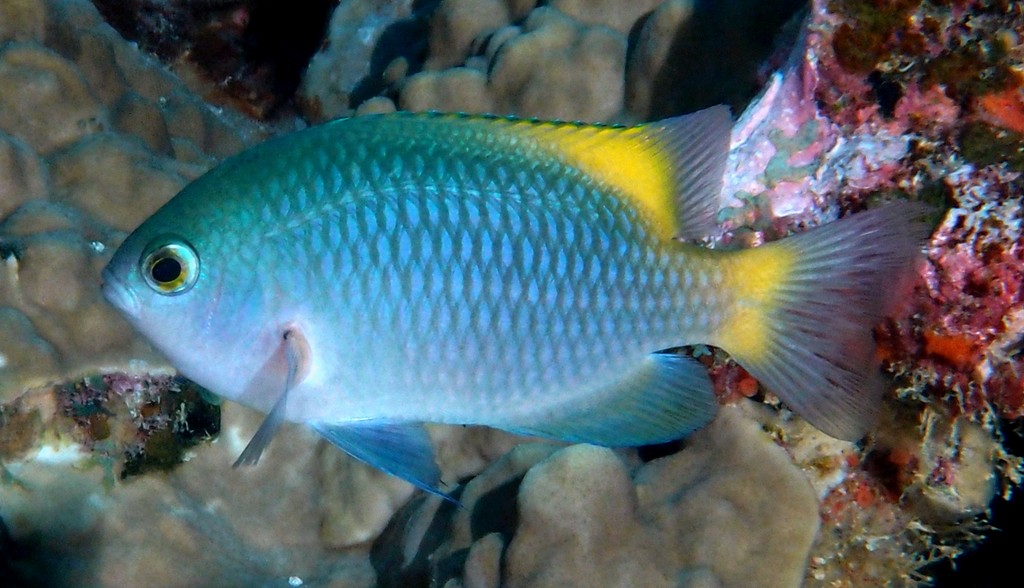POMACENTRUS LEPIDOGENYS - (FOWLER & BEAN, 1928)
Actinopterygii (Gigaclass) > Actinopteri (Class) > Teleostei (Subclass) > Blenniiformes (Order) > Pomacentridae (Family) > Pomacentrinae (Subfamily) > Pomacentrus (Genus)
Demoiselle à nombreuses écailles, Scaly damsel, Scaly damselfish, Asado-suzumedai, アサドスズメダイ, 頰鱗雀鯛,
Demoiselle à nombreuses écailles, Scaly damsel, Scaly damselfish, Asado-suzumedai, アサドスズメダイ, 頰鱗雀鯛,
Description
Dorsal spines (total): 13; Dorsal soft rays (total): 14-15; Anal spines: 2; Anal soft rays: 14-15; Pectoral fin rays: 18; Lateral-line scales: 17-18; Gill rakers: 20-22; Body Depth: 2.0-2.4 in SL. Body ovate, compressed. Posterior margin of preopercle weakly serrate. Suborbital scaled, with smooth ventral margin. Teeth on jaws biserial, incisor-like. Caudal fin emarginate; no conspicuous projecting spine-like rays at upper and lower edges of caudal-fin base. Max length: 9.0 cm SL. Depth range: 1 - 12 m.
Color
Head and body pale bluish gray darkened dorsally, except for posterodorsal part of body yellow; posterior and anterior parts of dorsal and caudal fins, respectively, tinged with yellow.
Etymology
Pomacentrus: from Greek, poma, -atos = cover, operculum + from Greek, kentron = something with a sharp point: point, spike, spur, sting, quill, thorn. Referring to serrations and prickles along margins of opercular bones of Pomacentrus pavo.
Lepidogenys: from Latin, lepido = scale + from Latin, gena = cheek with reference to the scaled suborbitals.
Original description: Pomacentrus lepidogenys Fowler & Bean, 1928 - Type locality: Ligpo Point, Balayan Bay, Philippines.
Distribution
Indo-West Pacific: Andaman Sea to Palau, Australia, Vanuatu and New Caledonia.
Biology
Adults inhabit lagoons, passages, and outer reef slopes. Feed on zooplankton in the water column, a short distance from the bottom. They occur singly or in small groups. Oviparous, distinct pairing during breeding. Eggs are demersal and adhere to the substrate. Males guard and aerate the eggs.
Similar species
Neopomacentrus bankieri (Richardson, 1846) - Reported from New Caledonia.
Pomacentrus callainus (Randall, 2002) - Reported from Tonga and Fiji - Formely identified as a colour variety of the western Pacific Pomacentrus lepidogenys. It is distinct from Pomacentrus lepidogenys in its overall blue-green colour with a wedge-shaped black spot at the upper base of the pectoral fin, higher gill raker counts (22-25, compared to 20-23 for Pomacentrus lepidogeys), deeper body (47.5-51% SL compared to 43.5-47% SL, for Pomacentrus lepidogenys), longer dorsal spines (longest spine 14.7-17.1% SL, compared to 12.7-14.7% SL in Pomacentrus lepidogenys), and probable larger size.
Dorsal spines (total): 13; Dorsal soft rays (total): 14-15; Anal spines: 2; Anal soft rays: 14-15; Pectoral fin rays: 18; Lateral-line scales: 17-18; Gill rakers: 20-22; Body Depth: 2.0-2.4 in SL. Body ovate, compressed. Posterior margin of preopercle weakly serrate. Suborbital scaled, with smooth ventral margin. Teeth on jaws biserial, incisor-like. Caudal fin emarginate; no conspicuous projecting spine-like rays at upper and lower edges of caudal-fin base. Max length: 9.0 cm SL. Depth range: 1 - 12 m.
Color
Head and body pale bluish gray darkened dorsally, except for posterodorsal part of body yellow; posterior and anterior parts of dorsal and caudal fins, respectively, tinged with yellow.
Etymology
Pomacentrus: from Greek, poma, -atos = cover, operculum + from Greek, kentron = something with a sharp point: point, spike, spur, sting, quill, thorn. Referring to serrations and prickles along margins of opercular bones of Pomacentrus pavo.
Lepidogenys: from Latin, lepido = scale + from Latin, gena = cheek with reference to the scaled suborbitals.
Original description: Pomacentrus lepidogenys Fowler & Bean, 1928 - Type locality: Ligpo Point, Balayan Bay, Philippines.
Distribution
Indo-West Pacific: Andaman Sea to Palau, Australia, Vanuatu and New Caledonia.
Biology
Adults inhabit lagoons, passages, and outer reef slopes. Feed on zooplankton in the water column, a short distance from the bottom. They occur singly or in small groups. Oviparous, distinct pairing during breeding. Eggs are demersal and adhere to the substrate. Males guard and aerate the eggs.
Similar species
Neopomacentrus bankieri (Richardson, 1846) - Reported from New Caledonia.
Pomacentrus callainus (Randall, 2002) - Reported from Tonga and Fiji - Formely identified as a colour variety of the western Pacific Pomacentrus lepidogenys. It is distinct from Pomacentrus lepidogenys in its overall blue-green colour with a wedge-shaped black spot at the upper base of the pectoral fin, higher gill raker counts (22-25, compared to 20-23 for Pomacentrus lepidogeys), deeper body (47.5-51% SL compared to 43.5-47% SL, for Pomacentrus lepidogenys), longer dorsal spines (longest spine 14.7-17.1% SL, compared to 12.7-14.7% SL in Pomacentrus lepidogenys), and probable larger size.
